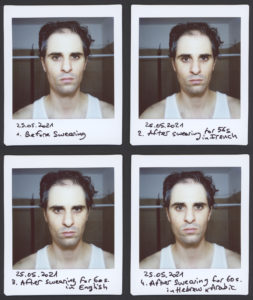For a long time I thought that Winogrand’s famous phrase was a joke, when he said “I photograph to find out what something will look like photographed.”
Then, one day, I started wondering what, of the passage of time, registers on the face, that we might be able to grasp with the same person, the same lighting, the same camera, the same film—instant film preferably, to avoid any further alteration of the image.
Curious but unsure what I would find, I set out to photograph my face over and over again, trying to grasp both the long term change of a baseline (“Who Shows Up“, yet to be uploaded) but also the possible impact of specific micro-events (the “Before | After” series, more of which will be uploaded soon) or a preparation (“Res Publica“).
This ongoing work can be observed in the projects below. I continue discussing the projects under their thumbnails.
These are different projects for sure, but together they probe the same types of questions, and from what linguists would call a “semasiological” perspective: I did not shoot based on meaning, trying to find the forms that a particular feeling of change took (this would have been the “onomasiological” approach). I shot based on a specific time, not at any moment that felt meaningful and prompt me to grab the camera, but rather at set times planned beforehand, for instance immediately at wake-up, trying to see what this formal setup can yield in terms of meaning. Wake up time is not entirely arbitrary either: it is a reproducible time, and one where a person might be the most removed from the public view. Again, that there is meaning in choosing this moment does not take anything away from the fact that the camera was grabbed because it was formally the time to do so—not because any feelings inside made me want to take the picture, other than the pursuit of the project. It is the same with the other projects, where the “Before” and “After” shot are defined by the start and end of the micro event, not because. I feel there might be a change. The possible change is hypothesized and then tested, through photography.
There are important differences too:
Who Shows Up banks on our mind’s ability to even out the micro-differences due to framing, head position, etc., so that we might see emerge, over time and through the repetition of pictures every 24 hours or so, what remains: a cartography of the facial change spotted at a private, unguarded moment.
Before | After looks rather at the possible micro-effects of limited events, big and small, as recorded on the face over a very short-term temporality. The basis for this is not entirely solid: when we go to school, for instance, many micro-events intersect: we might get exposed to a particularly hot sun, waste time at the gas station or meet uncivil drivers, which can be an aggravating factor. Furthermore, it can be assumed that whatever changes are felt in the moment, things might go back closer to a certain baseline, as mood is said to do. But all the events included in what “going to school” entails, and all the nuances possibly registered, testify to the experience as it is lived, and if it leaves a mark, if temporary, I’m curious to find it. This is not “narrative” photography, but rather an experimental approach, albeit not a very scientific one.
The same can be said of “Res Publica”: though the proximity of images inevitably recalls genres of narrative storytelling through images, it is not the intent. The goal is rather to trace the visual evolution of a visage that is preparing to “face” the world.


